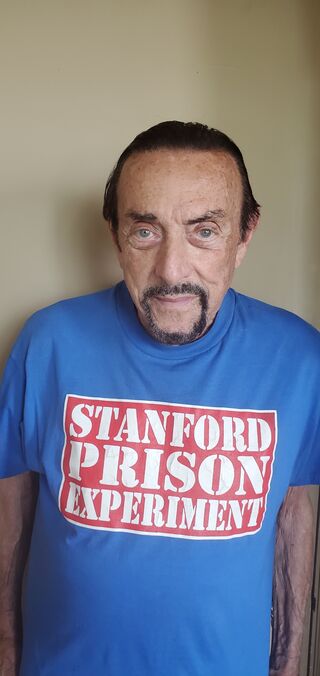Shyness
50 Years On: What We've Learned From the Stanford Prison Experiment
The experiment generated important research into unexplored territories.
Posted August 16, 2021 Reviewed by Tyler Woods
Key points
- I developed 3 new areas of research after the Stanford prison experiment (SPE): good and evil, time perspective, and shyness.
- The SPE was closed down after 6 days because the "guards" became so brutal and as Superintendent, I was too caught up in my role.
- The Heroic Imagination Project teaches people how to be Everyday Heroes and take effective actions in challenging situations.

Fifty years ago this month I conducted a research experiment that could have been a blight to my career. Instead, what has become known as the Stanford prison experiment (SPE) drove me to extensively pursue the question: Why do good people do evil things? After three decades of research on this subject, I recorded my findings in The Lucifer Effect: Understanding How Good People Turn Evil (Random House, 2007).
But the SPE also led me to research three new topics that hadn’t previously been studied:
1) Heroism: Why, in difficult situations, some people heroically step forward to help others, oftentimes complete strangers, while others stand by and watch.
2) Time Perspective: The psychological time warp experienced by participants of the SPE—not knowing if it was day or night or what day it was—led to my research in people’s individual time perspectives and how these affect our lives.
3) Shyness: Rethinking shyness as a self-imposed psychological prison led me to conduct research on shyness in adults, and then create a clinic in the community designed to cure shyness.
The Experiment in a Nutshell
In August 1971, I led a team of researchers at Stanford University to determine the psychological effects of being a guard or a prisoner. The study was funded by the US Office of Naval Research as both the US Navy and the US Marine Corps were interested in the causes of conflict between military guards and prisoners. In the study, 24 normal college students were randomly assigned to play the role of guard or inmate for two weeks in a simulated prison located in the basement of the Stanford Psychology Department building. But the guards quickly became so brutal, and I had become so caught up in my role as Superintendent, that I shut down the experiment after only six days.
Challenging the Truth
There seem to be powerful silent barriers to dealing with new truths emanating from psychological laboratories and field experiments that tell us things about how the mind works, which challenge our basic assumptions. We want to believe our decisions are wisely informed, that our actions are rational, that our personal conscience buffers us against tyrannical authorities. Moreover, we want to believe in the dominating influence of our good character despite social circumstances. Yes, those personal beliefs are sometimes true, but often they are not, and rigidly defending them can get us in trouble individually and collectively. Let’s see how.
Denial and Finger Pointing
When we discover two or three ordinary American citizens administered extreme electric shocks to an innocent victim on the relentless commands of a heartless authority, we say, “no way, not me.” Yale University psychologist Stanley Milgram’s obedience to authority research has been in the public arena for decades, yet we ignore its message of the power of unjust authority in undercutting our moral conscience. Similarly, the SPE research made vivid the power of hostile situational forces in overwhelming dispositional tendencies toward compassion and human dignity. Still, many who insist on honoring the dominance of character over circumstance reject its situational power message.
In 2004, people around the world witnessed online photos of horrific actions of American Military Police guards in Iraq’s Abu Ghraib Prison against prisoners in their charge. It was portrayed as the work of a “few bad apples” according to military brass and Bush administration spokespeople. I publicly challenged this traditional focus on individual dispositions by portraying American servicemen as good apples that were forced to operate in a Bad Barrel (the Situation) created by Bad Barrel Makers (the System).
I became an expert witness in the defense of the Staff Sergeant in charge of the night shift, where all the abuses took place. In that capacity, I had personal access to the defendant, to all 1,000 photos and videos, to all dozen military investigations, and more. It was sufficient to validate my view of that prison as a replica of the Stanford prison experiment on steroids, and of my defendant, Chip Frederick, as really a Good Apple corrupted by being forced to function for 12 hours every night for many months in the worst barrel imaginable. My situation-based testimony to the military Court Martial hearings helped reduce the severity of his sentence from 15 years down to only four years.
The January 6, 2021 insurrection is a recent example of some Good Apples being corrupted by a Bad Barrel. In this case, the Bad Barrel is the insidiousness of fascism led by the former president and other fraudulent politicians as well as media personalities. These “leaders” have been generously dumping poison in the Barrel and over the Apples with lies that feed the Apples’ deepest fears.
“The Stanford Prison Experiment” Film
In 2015, The Stanford Prison Experiment was made into a film starring Billy Crudup as me and Olivia Thrilby as Christina Maslach, the whistle-blowing graduate student (whom I later married) who pointed out the experiment had gone awry and had changed me to such a degree that she didn’t know who I was anymore. Her personal challenge led me to end the study the next day. The film received two awards at the Sundance Film Festival: best screenwriting and best science feature.

The Stanford Prison Experiment movie enables viewers to look through the observation window as if they were part of the prison staff watching this remarkable drama slowly unfold, and simultaneously observe those observers as well. They are witnesses to the gradual transformations taking place, hour by hour, day by day, and guard shift by guard shift. Viewers see what readers of The Lucifer Effect book account can only imagine. As these young students become the characters inhabited in their roles and dressed in their costumes, as prisoners or guards, a Pirandellian drama emerges.
The fixed line between Good, like us, and Evil, like them, is relentlessly blurred as it becomes ever more permeable. Ordinary people soon slip into doing extraordinarily bad things to other people, who are actually just like them except for a random coin flip. Other healthy people soon get sick mentally, being unable to cope with the learned helplessness imposed on them in that unique, unfamiliar setting. They do not offer comfort to their buddies as they break down, nor do those who adopt a “good guard” persona ever do anything to limit the sadistic excesses of the cruel guards heading their shifts.
Finally, the movie also tracks the emotional changes in the lead character (me) as his compassion and intellectual curiosity get distilled and submerged over time. The initial roles of research creator and objective observer are dominated by power and insensitivity to prisoners' suffering in the new role of Prison Superintendent.
Visit the official Stanford Prison Experiment website to learn more about the experiment.
Heroic Imagination

I should add that, along with continuing research in time perspectives and time perspective therapy, my new mission in life has been to empower everyone to wisely resist negative situational forces and evil by becoming Everyday Heroes in Training. Our non-profit Heroic Imagination Project (HIP) teaches ordinary people how to stand up, speak out and take effective actions in challenging situations in their lives.




